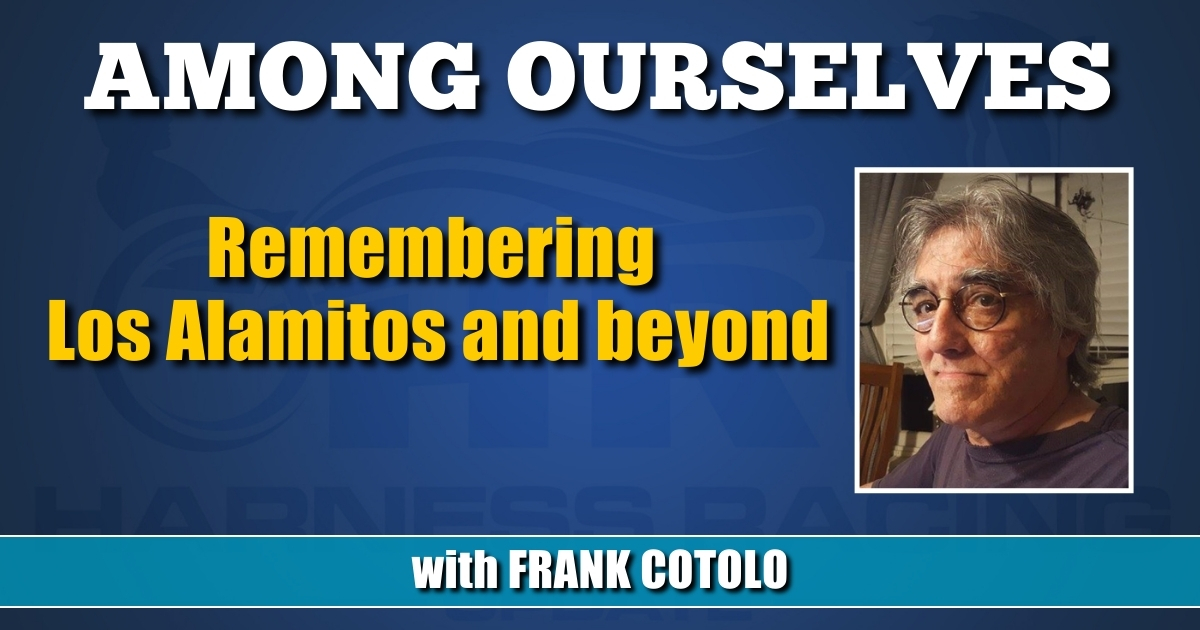

Remembering Los Alamitos and beyond
by Frank Cotolo
Part 1 ishere.
Part 2 is here.
Bulldozers leveled Hollywood Park to sawdust in 2014. Its 260 acres were replaced by a housing development and an entertainment complex (which included a casino and an NFL stadium). The remnants of horse racing were exculpated to the extent of moving the graves and monuments of champion thoroughbreds to other tracks and horses’ breeding grounds. Statues of Swaps and Bill Shoemaker were placed into storage; somewhere.
Los Alamitos Racetrack did not experience the fate of Hollywood Park. Quite the opposite. It was eventually renovated to become a part of a newer and healthier California thoroughbred racing circuit. But in the 1980s the Orange County five-eighths mile track featured three breeds of horse racing throughout the years. The pecking order included quarter horses and standardbreds and thoroughbreds.
The 21-or-so miles from Hollywood proper was a tedious drive; especially when I made the trip alone because Mr. Bruce was too busy elsewhere on particular racing nights. Getting to the track for an evening’s first harness-program post meant battling rush-hour traffic bottlenecks heading towards the inland empire. When I made the ride alone it was a test of devotion; when Mr. Bruce was with me it was a cacophony of laughter defying any road stress.
Los Al was a different theater than Hollywood Park. Mr. Bruce said it had “a dark vibe.” It was dark green and rusty brown compared to Hollywood’s orange motif. It looked weathered and appeared no better in shape and atmosphere than when it was in constant disrepair due to rain damage during its first race meet in 1951. But the harness faithful in the ’80s endured. We gladly paid the parking and admission and program prices to share the action with the equine and human athletes changing venues from Inglewood to Los Alamitos. On the smaller stage were the same trotters and pacers handled by the same West Coast-based trainers and drivers. We were a part of their caravan.
We wagered more money at Los Al than we did at Hollywood because we were making more money from our professions. A $30 win on Manga Hawk (Robert Sleeth in the bike) returned $216; nearly a one-bedroom month’s rent. And as the racing ensued it turned out that respecting the under-rated Sleeth awarded us some of our best investments on the three-turn mile. Los Al flourished for us with other drivers; Frank Sherren and Joe Anderson and Ross Croghan often over-performed the public’s odds for our benefit.
One day Mr. Bruce got he and I a job as extras in the second-unit production of the movie “Meteor.” It called for an afternoon of running around a public park as if shards of space rocks pummeled to Earth. The Orange County park doubled as an Italian town and the gig offered free lunch as well as cash. The shoot ended in plenty of time for us to make the first race that night. (Watching the film today reveals our brief appearances).
The Los Alamitos experiences also furthered my harness racing journalism success as they inspired material; I enjoyed income from published works about betting on harness racing. There were many periodicals covering the sport in the ’80s. My byline appeared in Sulky, Hoof Beats, Harness Horse and Gambling Times. The pay was substantial.
A bulging bankroll developed and nothing prompts a gambler more than having extra money to dump into the pari-mutuel pools. Mr. Bruce and I became confident enough from our harness betting investments to attempt expanding. We took on the quarter horses at Los Al between harness meets. We traveled the turnpikes with bloated egos only to not last for a single quarter-horse program. Handicapping the sprinters was baffling and the action less dramatic as it presented blink-of-an-eye contests. As different as chalk and cheese for us harness experts. We laughed at the experience and held our breaths to return for the next harness meet.
But all was not well…
California harness racing in the ’80s was only surviving due to die-hard fans like Mr. Bruce and I. The crowds once shoulder to shoulder on the aprons reduced by the month and left much space for bettors to stroll freely. Even our appearances lessened, but that was mostly due to professional and personal interruptions. Where did the others go?
We still stole time whenever we could to attend the two closest harness venues (a meet took place in Sacramento but it was out of our commuting range) but others did not. Could it be curtains for harness racing all together out west?
My harness racing contacts offered a glimmer of hope in the shape of a new racing venue in the Pomona Valley; 30 miles east of Hollywood proper. I was told there were racetracks there on the Los Angeles County Fairgrounds. One for auto-drag racing and there was a five-eighths track used for thoroughbreds during fairs. It was called Fairplex Park.














